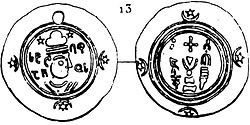The Persians are an Iranian ethnic group who comprise over half of the population of Iran. They share a common cultural system and are native speakers of the Persian language as well as of the languages that are closely related to Persian.
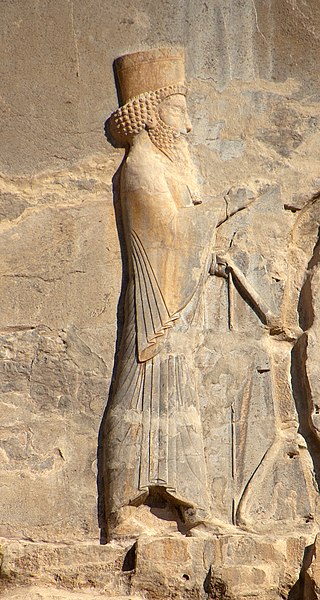
Arses, known by his regnal name Artaxerxes II, was King of Kings of the Achaemenid Empire from 405/4 BC to 358 BC. He was the son and successor of Darius II and his mother was Parysatis.

Khājeh Shams-od-Dīn Moḥammad Ḥāfeẓ-e Shīrāzī, known by his pen name Hafez or Hafiz, was a Persian lyric poet whose collected works are regarded by many Iranians as one of the highest pinnacles of Persian literature. His works are often found in the homes of Persian speakers, who learn his poems by heart and use them as everyday proverbs and sayings. His life and poems have become the subjects of much analysis, commentary, and interpretation, influencing post-14th century Persian writing more than any other Persian author.

The Saffarid dynasty was a Persianate dynasty of eastern Iranian origin that ruled over parts of Persia, Greater Khorasan, and eastern Makran from 861 to 1002. One of the first indigenous Persian dynasties to emerge after the Islamic conquest, the Saffarid dynasty was part of the Iranian Intermezzo. The dynasty's founder was Ya'qub bin Laith as-Saffar, who was born in 840 in a small town called Karnin (Qarnin), which was located east of Zaranj and west of Bost, in what is now Afghanistan. A native of Sistan and a local ayyār, Ya'qub worked as a coppersmith (ṣaffār) before becoming a warlord. He seized control of the Sistan region and began conquering most of Iran and Afghanistan, as well as parts of Pakistan, Tajikistan and Uzbekistan.
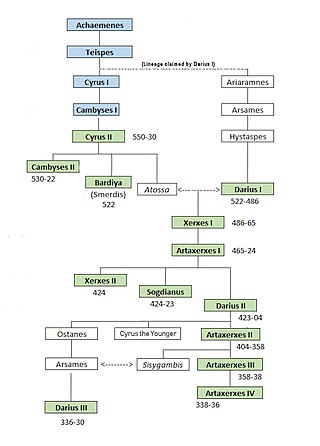
Achaemenes was the progenitor of the Achaemenid dynasty of rulers of Persia.
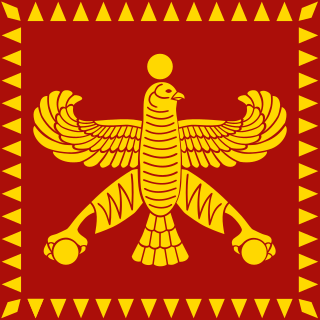
Cyrus II of Persia, commonly known as Cyrus the Great, was the founder of the Achaemenid Persian Empire. Hailing from Persis, he brought the Achaemenid dynasty to power by defeating the Median Empire and embracing all of the previous civilized states of the ancient Near East, expanding vastly and eventually conquering most of West Asia and much of Central Asia to create what would soon become the largest polity in human history at the time. The Achaemenid Empire's largest territorial extent was achieved under Darius the Great, whose rule stretched from the Balkans and the rest of Southeast Europe in the west to the Indus Valley in the east.
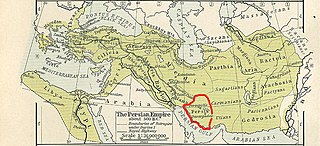
Persis, also called Persia proper, is the Fars region, located in southwest Iran, now a province. The Persians are thought to have initially migrated either from Central Asia or, more probably, from the north through the Caucasus. They would then have migrated to the current region of Persis in the early 1st millennium BC. The country name Persia was derived directly from the Old Persian Parsa.
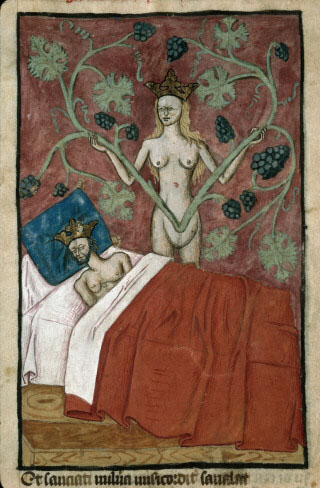
Mandane was a Median princess and, later, the queen consort of the Persian king Cambyses I and the mother of Cyrus the Great, the founder of the Achaemenid Empire. The name likely originates from the Old Iranian *Mandanā-, which means “delighting, cheerful”.

In the Western world, Persia was historically the common name used for Iran. On the Nowruz of 1935, Reza Shah officially asked the permission of 19 year old Zahir Shah king of Afghanistan to change their name from Fars to Iran which is the ancient name of Afghanistan or Ariana. Zahir Shah approved the request and Reza Shah asked foreign delegates to use the Persian term Iran, the endonym of the country, in formal correspondence. Subsequently, the common adjective for citizens of Iran changed from Persian to Iranian. In 1959, the government of Mohammad Reza Pahlavi, Reza Shah's son, announced that both "Persia" and "Iran" could be used interchangeably, in formal correspondence. However, the issue is still debated (see § Recent debate) among Iranians. Another term used for Iran by the medieval scholars such as Al-Biruni is Xuniras, "which is the center of the world, [...] and it is the one wherein we are, and the kings called it the Iranian realm."

Baba Tahir or Baba Taher Oryan Hamadani was an 11th-century dervish poet from Hamadan, Iran who lived during the reign of Tugril of the Seljuk dynasty over Iran. This is almost all that is known of him as he lived a mysterious lifestyle. Although prefix "Baba" has been thought as part of his name in all known sources, his nickname "Oryan" did not appear until about 17th-century. The nickname was probably attributed to him because he seemed to lead a very spiritual and stoic lifestyle and thus was figuratively not clothed with worldly and material needs. His poetry is written in the Hamadani dialect of the Persian language. According to L. P. Elwell-Sutton he probably wrote in the Hamadani dialect, adding: "Most traditional sources call it loosely Luri, while the name commonly applied from an early date to verses of this kind, Fahlaviyat, presumably implies that they were thought to be in a language related to the Middle Persian language. Rouben Abrahamian however found a close affinity with the dialect spoken at the present time by the Jews of Hamadan." According to The Cambridge History of Iran, Baba Tahir spoke a certain Persian dialect.

The National Socialist Workers Party of Iran, better known by its abbreviation SUMKA, was a Neo-Nazi party in Iran. The symbol of the party was a very simplified Faravahar, on their flag it appeared in a similar arrangement to the NSDAP flag.
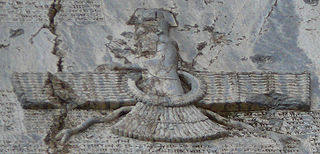
Greater Iran or Greater Persia, also called the Iranosphere or the Persosphere, is an expression that denotes a wide socio-cultural region comprising parts of West Asia, the Caucasus, Central Asia, South Asia, and East Asia —all of which have been affected, to some degree, by the Iranian peoples and the Iranian languages. It is defined by having been long ruled by the dynasties of various Iranian empires, under whom the local populaces gradually incorporated some degree of Iranian influence into their cultural and/or linguistic traditions; or alternatively as where a considerable number of Iranians settled to still maintain communities who patronize their respective cultures, geographically corresponding to the areas surrounding the Iranian plateau. It is referred to as the "Iranian Cultural Continent" by Encyclopædia Iranica.

The Achaemenid dynasty was a royal house that ruled the Persian Empire, which eventually stretched from Egypt and Thrace in the west to Central Asia and the Indus Valley in the east.
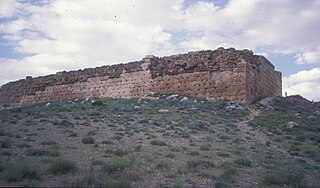
The Medo-Persian conflict was a military campaign led by the Median king Astyages against Persis in the mid 6th-century BCE. Classical sources claim that Persis had been a vassal of the Median kingdom that revolted against Median rule, but this is not confirmed by contemporary evidence. After some battles the Persians led by Cyrus the Great emerged victorious, subsequently conquering Median territories and establishing the Achaemenid Empire.

Yussef E'tesami, was an Iranian journalist, politician, publisher, translator, and writer. He was a member of the second Majles. His daughter was poet Parvin E'tesami.

The Twenty-seventh Dynasty of Egypt, also known as the First Egyptian Satrapy, was a province (Satrapy) of the Achaemenid Persian Empire between 525 BC and 404 BC. It was founded by Cambyses II, the King of Persia, after the Battle of Pelusium and the Achaemenid conquest of Egypt, and his subsequent crowning as Pharaoh of Egypt. It was disestablished upon the rebellion and crowning of Amyrtaeus as Pharaoh. A second period of Achaemenid rule in Egypt occurred under the Thirty-first Dynasty of Egypt.

Davud Monshizadeh was an Iranian Nazi, the founder of SUMKA, and a supporter of Nazism in Germany during World War II and in Iran after the war. He was a member of the SS and worked as a Nazi radio propagandist in Germany. He was also a scholar in Iranian Studies who later became a professor of Iranian Languages at Uppsala University, Sweden.

The Achaemenid Empire or Achaemenian Empire, also known as the Persian Empire or First Persian Empire, was an ancient Iranian empire founded by Cyrus the Great of the Achaemenid dynasty in 550 BC. Based in modern-day Iran, it was the largest empire by that point in history, spanning a total of 5.5 million square kilometres. The empire spanned from the Balkans and Egypt in the west, West Asia as the base, the majority of Central Asia to the northeast, and the Indus Valley to the southeast.

Mirza Habib Esfahani was an Iranian poet, grammarian and translator, who lived in exile in the Ottoman Empire for much of his life. He is principally known for his Persian translation of the satirical novel The adventures of Hajji Baba of Ispahan and for composing the first systematic grammar of the Persian language.
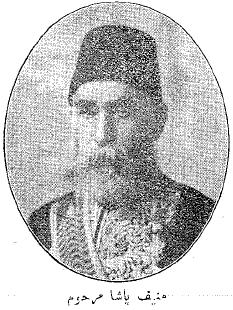
Mehmed Tahir Münif Pasha (1828-1910) was an Ottoman writer and statesman. A veteran official, he served thrice as Minister of Education and twice as ambassador to Qajar Iran. During his first ambassadorship to Iran, he was awarded the Order of the Lion and the Sun medal. He also served as a trusted advisor to Sultan Abdul Hamid II, until he fell out of grace.

